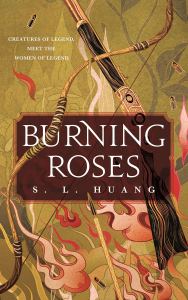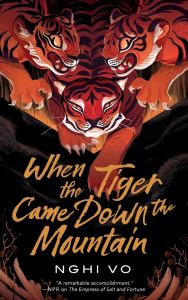Chinese-Inspired Fantasy Books That Reframe Familiar Fairy Tales
When the Tiger Came Down the Mountain, Burning Roses, and These Violent Delights make fairy tales familiar to Western audiences new again by incorporating Chinese history.

Reframing fairy tales has long been a common subgenre of fantasy fiction and, at the end of 2020, three authors put their own spins on stories (or fairy tale structures) familiar to most Western audiences by incorporating Asian mythology and settings. S. L. Huang combined European fairy tale Little Red Riding Hood with the Chinese tale of Hou Yi the Archer to form a story of redemption, love, and family in Burning Roses. Chloe Gong cast tragic English characters Romeo and Juliette as gangsters in 1920s Shanghai—pitting them against a Lovecraftian monster rising from the depths of the Huangpu River in These Violent Delights. And Nghi Vo continued her Singing Hills cycle, set in a world inspired by Imperial China, with an original story reminiscent of Middle Eastern folktale The Thousand Nights and One Night in the novella When the Tiger Came Down the Mountain. While none of these books are intended to be read together, all three make an excellent combination of courses for your literary meal, especially if you’re looking to dive into more fantastical tales written by Asian American authors.

Burning Roses by S.L. Huang
Fairy tales frequently feature young protagonists, especially young women, in peril. Some are able to evade dire fates through their own wits, while others must be rescued. Readers seldom see what becomes of them in their middle age, but that’s exactly what Huang takes on in her novella, Burning Roses.
Red Riding Hood, here called Rosa, survived the wolf attack that killed her grandmother. The event convinces her of the evil of the grundwirgen, speaking animals whom her grandmother had tried to teach here were just as much people as humans, but whom her mother had raised her to hate. Her mother’s point proven right, she sets off on a quest to rid the world of grundwirgen, teaming up with Goldie (whom she rescued from bears, and whom she later realizes is a thief and a con artist). But by the time readers meet Rosa, she’s left that life long behind, and now accompanies Hou Yi, the famous archer of Chinese lore, on a quest to keep people safe from unthinking monsters. (Hou Yi is traditionally described as male; here she is female, and she complains that Westerners from Rosa’s lands “insist on calling me a man.”)
Hou Yi, like Rosa, has her own demons to slay, and not just the literal ones. As Hou Yi and Rosa fight off a group of sunbirds, nearly dying from the smoke and fire, Hou Yi is confronted by her own past—the apprentice who turned against her. That apprentice is now a sorcerer, and has raised the sunbirds against Hou Yi in a twisted act of revenge.
But of course, it’s not that simple, either. Hou Yi and Rosa both acknowledge their own troubled pasts, and the wrongs they’ve both done, especially to those they love, weigh them down so heavily they almost cannot bear to move. The relationship between these two women, who truly see each other because they recognize a kinship of regret and repentance, is powerful. Without revealing too much in the way of spoilers, the feeling of the novella is that even in the midst of despair, it is possible to hope—especially when someone else can help carry the burden of your past.
Along with nods to Goldilocks and Little Red Riding Hood, there are additional mentions of Western fairy tales like Puss in Boots and Sleeping Beauty. Hou Yi’s story also closely mirrors the traditional tales, but familiarity with them isn’t required; those who already know the story may catch hints in the story earlier about where the tale will end, but Huang’s use of folklore from both Europe and China is complete within the story, and no additional outside sources are needed to get full enjoyment from the tale.

These Violent Delights by Chloe Gong
What happens when you mix 1920s Shanghai with The Sopranos, Lovecraftian horror, and Romeo and Juliet? With Gong at the helm, the result is a chillingly violent romance that readers may hope, despite the source material, will come to a happy ending.
In These Violent Delights, Juliette and Roma are the heirs to the two gangs of Shanghai, crime families who once controlled the city but are both losing ground as more foreign interests—and communists—rise to power. Juliette Cai is the future leader of the Scarlet Gang, the only remaining Chinese power in the city. Roma Montagov is a White Flower, son of generations of Russians who fled the Bolsheviks, and now in a dangerous predicament as his father has begun to favor another Montagov over his own son as the possible heir. Years ago, Juliette and Roma met in secret, determined to defy their parents, pledging that together they could bring peace and prosperity to Shanghai.
But those years are long past, and now nothing exists between them but hatred—or so each of them claim. They would continue to be solely enemies if not for a contagion sweeping through the city, hitting Scarlets and White Flowers with equal severity, that causes the victims to rip out their own throats. The contagion seems to follow sightings of a monster—a creature that witnesses claim drives people mad. Investigating on their own, they are chasing their own tails. Together, they could be unstoppable…
Before you say that the story isn’t really a fairy tale—it long predated Shakespeare’s play—and while it includes no fairies, the element of the poison that emulates death borders on the supernatural. Gong’s addition of a monster that rises from the river and compels people to suicide brings in enough additional supernatural elements (mixed with a healthy dose of 1920s science) to include it within the genre. At the same time, the novel is just as much a crime drama; the feuding criminal families are vibrantly, violently drawn, and their ruthlessness makes it difficult to consider heroes (even while readers root for Roma and Juliette’s romance).
One of the delights of the story, for those familiar with Shakespeare’s telling of the tale, is watching Gong’s naming conventions give clues to the role the characters play. Lourens, a scientist working with the White Flowers, is an analog to Father Laurence; Benedikt and Marshall are Romeo’s friends Benvolio and Mercutio, while Juliette’s hotheaded cousin Tyler is Tybalt. But though they don’t always play into type (and they have their own motives far beyond the traditional tale), readers will still be waiting for that moment when Tyler and Marshall face off, and Marshall lays a plague on both their houses. That the story, while self contained, leads directly into a subsequent volume will have readers waiting to find out if fair Shanghai will one day see a glooming peace, and whether Roma and Juliette must both be sacrificed to achieve it.

When the Tiger Came Down the Mountain by Nghi Vo
Vo’s novella is the second story featuring scholar-cleric Chih, who collects stories from far off places in order for them to be recorded for the archives at Singing Hills. In Chih’s first story (The Empress of Salt and Fortune), they and their recorder bird, Almost Brilliant, had an adventure; now Almost Brilliant is tending a clutch of eggs, leaving Chich to journey on their own. Luckily, Chich has guide Si-yu, a mammoth corps scout, to lead them through the mountains.
Unluckily, there are three tigers hunting in the mountains, and a lone mammoth and a few humans seem like a tasty meal. Si-yu and her mammoth, Piluk, reach safety, and Chih calls an uneasy truce with the tigers: Chih knows the tale of Ho Thi Thao’s marriage, and they ask the tigers to correct it for Singing Hills. The tigers refuse to tell their version—the true version—but they’re willing to let Chih tell the version they know, and correct the cleric when they get things wrong.
And so Chih tells the story of Ho Thi Thao and her human wife, Scholar Dieu—all the while, during the tale, keeping the hungry tigers from eating the humans. Chih weaves elements of ghosts—and the tigers add fox spirits, correcting the story; Chih gives a version in which human Dieu has most of the agency, and the tigers correct the tale to make Ho Thi Thao the hero. The story always feels very tightly organic to the Singing Hills cycle: the mammoths are a particularly delightful element of the setting, and the talking tigers, who can take the form of humans, feel a true part of the setting once readers (and Si-yu) become accustomed to the idea of conversing with them. In fact, Si-yu often takes the side of the tigers, preferring the details they give the story to Chih’s version.
But while the world is very much its own, the story is very reminiscent of the traditional tale of Scheherezade, who staved off death with her stories night after night. While When the Tiger Came Down the Mountain feels very much a new story, it also feels familiar, the way that being tucked in with a familiar bedtime story might, especially for readers accustomed to bedtime stories with the threat of being eaten by tigers.
For the two stories with already familiar characters, the Chinese (or Chinese-inspired) settings offer a new perspective for readers less familiar with East Asian mythology, and help readers to see those tales in a new and different light, enhancing the old tales with a new point of view. For the original story, embracing the feel of older tales lends it the feeling of being at once both new and comforting. In all ways, these three tales offer the sense of meeting old friends for the first time—and coming out the other side enriched by the experience.
